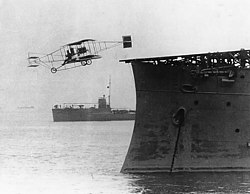An interesting footnote on Ely:
Ely was a civilian at the time of this flight and a salesman for Curtiss. He went around the country doing demonstration flights and selling aircraft. He must have been one hell of a salesman as he convinced the Navy he could fly off of and on to a ship at sea.
On November 14, 1910 Ely flew from the deck of the USS Birmingham at Hampton Roads, VA and landed two miles away. This was followed by an arrested landing on January 18, 1911 aboard the USS Pennsylvania anchored in San Francisco Bay. Ely is wearing a suit along with a leather football helmet and a rubber bicycle tire wrapped around his torso as a personal flotation device “just in case”. The helmet is most likely being worn in response to Army Lt. Selfridge’s death. Lt. Selfridge was the first passenger to be killed in powered flight. He was aboard a Wright Flyer along with Orville Wright while doing flight demonstrations for the Army at Fort Meade, MD on September 17, 1908 when the aircraft crashed, Wright was badly injured and Selfridge killed from head injuries. Army pilots were required to wear head protection afterwards. Lt. Selfridge was a West Point graduate in the same class as Douglas MacArthur. The first pilot to die was the Frenchman Eugène Lefèbvre on September 7, 1909 flying a Wright Model A.
Ely went on a few months later to enlist in the California Army National Guard, was commissioned a lieutenant, and was the National Guard’s first aviator. He delivered the Army’s second aircraft (the first was a Wright Flyer) and trained Army pilots to fly. While performing a flight demonstration in Macon, Georgia to a crowd on October 19, 1911 he crashed and was killed. Herbert Hoover posthumously awarded Ely the Distinguished Flying Cross in 1933.
The Naval Aviation Service was established on May 8, 1911 with the purchase of its first aircraft, a Curtiss Model D.






